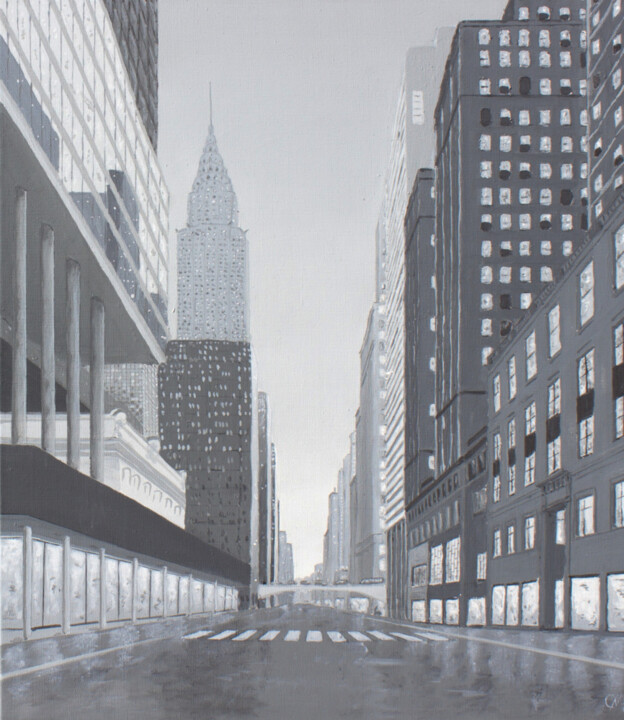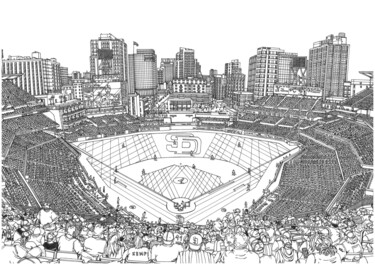 Elvira Gord, Manhattan bridge New York city, 2021. Oil on Canvas, 50 x 40 cm.
Elvira Gord, Manhattan bridge New York city, 2021. Oil on Canvas, 50 x 40 cm.
Beginning after the Second World War, the center of world art, the hothouse of all new trends, as well as the creative market, has gradually shifted from Paris to New York, therefore, an art historian from the old continent like me, cannot escape from pretending to ask for the fateful working vacations, prepare imaginary suitcases, buy a fake airplane ticket, maybe two, maybe even to go back, in order to catapult herself to the Big Apple, armed, only, with her bizarre imagination. As you have well understood, this is a fictitious journey, aimed at discovering some of the city's best-known landmarks, which will be analyzed not by the usual tour guide equipped with a dustpan, but by some of the most relevant masterpieces of themed art history. Returning to my trip, without mentioning any more of the fact that it is imaginary, avoiding any more unnecessary suffering and frustration, I will tell you how I will land at John Fitzgerald Kennedy International, after a harrowing nine-and-a-half hour flight, preceded by a four-and-a-half hour train transfer, which took me from Pisa to Milan, the place where I caught my blessed plane with destination Queens (New York). As soon as I set foot outside the airport, surely with killer mood swings, aimed at imaginatively combining tiredness and irritability with euphoria, joy and energy, I will take, as a means of locomotion, in order to move downtown, the iconic yellow cab, on which I will mount along with Andy Warhol and Jean Michel Basquiat. I didn't blow my mind, as, back in 1984 or so, the two aforementioned masters made precisely one themed work, depicting, through the stylings of a "child," a black boy intent on hailing a cab at 45th Street and Broadway (New York). Instead of John Fitzgerald Kennedy International we are in Midtown Manhattan, in order to "hear" the figurative tale of Taxi, 45th/Broadway, a work that tells us not about a journey, but about friendship and racism. In fact, the canvas, the result of the collaboration between the "intimates" Basquiat and Warhol, gives voice to a successful artistic partnership that took place between 1984 and 1985 and gave birth to a series of works in which, two of the most formidable artistic geniuses of the 20th century, united their precious point of view, although, as it appears with evidence, the younger artist's flair imposed itself drastically in the masterpiece. With regard to the second theme dealt with by the latter, it only becomes apparent if one looks carefully at the detail, which appears on the shirt of the black man intent on expectorating the cab, namely the inscription "nigger," a derogatory meant to identify him in an explicit, racist and brutal way. Effectively, it is due precisely to the color of his skin that the imprecatory white taxi driver blatantly ignores the potential passenger's request, an event entirely designed to harken back to a reality extremely familiar to Basquiat, who, despite his meteoric rise in the New York art scene, was always ready to clash with similar discriminatory vileness.
 Edith Verdickt, Taxis Jaunes. Oil on canvas, 73 x 92 cm.
Edith Verdickt, Taxis Jaunes. Oil on canvas, 73 x 92 cm.
This tale "in yellow" continues from another point of view, that is, no longer from the perspective of the streetwalker, but from that of the cab driver, well "played" by Joseph Rodriguez, taxi driver-photographer, who, in the New York of the 1970s and 1980s, precisely during his shifts, began to create his first works, documenting a street life full of multiple encounters and unpredictable situations. In this context, Rodriguez's work seems to unveil a mystery: his images bear witness to the fascinating aura of taxi drivers, who, in a rather unsuspected way, turn out to be great observers and connoisseurs of humankind. Having "revealed" the first symbol of New York City, that is, the yellow cab, I resume the narrative of my journey, which, in addition to setting out to make concrete in the future, I imagine crossing Time Square, a place where I materialize "armed" with a great doubt to solve: which shack among the many welcomed in the street will make the tastiest hot dog???? My nonsense is "answered" by some of the best-known masters of art history, who have transformed one of the quintessential icons of the aforementioned city into an inedible, but highly inviting, specimen: I speak of the hot dog of Colin Self and Betty Spindler. As for the first British Pop artist, a contemporary of David Hockney and Peter Blake, his 1965 Hot dog sculpture was probably influenced by the typical approach of the movement "headed" by Andy Warhol, aimed at recognizing in fast food, and derivatives, subjects capable of revealing the frenzy of consumerist society. In the case of Self's sculpture, however, the chromatic "positivism" typical of Pop art gives way to a hot dog that, blackened, is transformed into an inconvenient instrument of denunciation, having the purpose of placing before the viewer's eyes a succulent "burned" dish, a mirror from the multiple atrocities committed by the wars in progress. Spindler's Hot dog (2000), compared to the dark and serious interpretation of Self, appears to be more superficial and carefree, since the succulent dish was "stuffed" by the artist with all her favorite ingredients, revealing also functional to help the most undecided spectator on ideas for dinner, who in the end will exclaim: hot dog tonight! Finally, packing my bags to go back to Europe, I reflect on my trip wondering why New York is also called the Big Apple, since if this appellation is certainly due to a succession of historical facts, in which the figures of Edward S Martin, John J. Fitgerald, Charles Gillet and Rudolph Giuliani alternate, even art can have its say, revealing the most hidden meanings of a highly popular fruit in Western figurative representation. From Adam and Eve by Albrecht Dürer, to the still lifes of Paul Cézanne and Vincent van Gogh, up to the Portrait of a young man with an apple by Raphael, etc. etc., the apple, another symbol par excellence of New York, has taken on opposite meanings and with very blurred boundaries, aimed at oscillating between good and evil, sin and good conduct. If imagining the two faces of New York, given the rich filmography in this regard, is not very difficult, to reveal further and unpublished points of view on Gotham City are the works of the artists of Artmajeur, such as those of Gorka Gonzalez Crespo, Jean Mirre and Christian Naura.
 Gorka Gonzalez Crespo, New York New York, 2021. Oil on canvas, 100 x 81 cm.
Gorka Gonzalez Crespo, New York New York, 2021. Oil on canvas, 100 x 81 cm.
Gorka Gonzalez Crespo: New York New York
The charm, elegance, refinement and demure beauty of the protagonist of Crespo's oil seems to give voice to a timeless, or unchanged, femininity since, despite the Artmajeur artist placing the woman in a precise time frame, which that of the Thirties, the person portrayed would seem to be both a girl of our times and those of Andy Warhol. I have just mentioned the master of Pop art precisely for the location of the painting, which, standing out against a background of soft lights pseudo belonging to the disco environment of the Big Apple, immediately reminded me of the iconic Studio 54, a popular New York club attended by, between 1977 and 1980, not only by the aforementioned master, but also by other well-known artists, literal icons of humanity. Indeed, if my imaginary association were made real, we could "see" the beautiful protagonist of New York New York dancing with Michael Jackson, talking about music with Mick Jagger and discussing art with Salvador Dalí, not to mention what might have happened if she had the honor of meeting Al Pacino, David Bowie, Lou Reed, etc, etc. Speaking of Studio 54, the venue, which was located between West 54th Street, between 7th and 8th Avenue in Midtown Manhattan (New York), is itself an icon, as it was the cradle of entertainment coveted in the whole world, determined the birth of the new concept of club, while distinguishing itself for the status of its guests, accepted by people that counted and dictated the rules of the time. Therefore, if my story were true, would you envy the girl from New York New York even for one night?
 Jean Mirre, New York, New York, 2021. Oil / ink on paper, 65 x 50 cm.
Jean Mirre, New York, New York, 2021. Oil / ink on paper, 65 x 50 cm.
Jean Mirre: New York New York
Art gives us the temporary "superpower" of being able to contemplate reality with new and different eyes, just as if we possessed a collection of lenses to wear, capable of making our perception range between the most diverse styles and artistic techniques. In the case of Jean Mirre we recognize in the "glasses" that the artist makes us wear Post-impressionist tendencies, which are "dirtied" by some hint of "naive" ingenuity. Precisely from this last trend I find the typical lack of perspective, the childish use of color and elementary drawing, even if, generally, the work of the artist of Artmajeur has greater affinities with the "heirs" of the Impressionists, who he interprets with a personal and extremely colorful point of view, which leads to a classification also akin to expressionism. In a nutshell, this vision of reality, the result of the very personal assimilation of multiple influences, gives life to a bird's eye view of the city of New York, in which the protagonists are the color blue, which envelops and "conceals" the multiple subjects, and the yellow of the clearly distinguishable figures of the four taxis whizzing by at speed, overtaking each other like remote-controlled toy cars. In the history of art there are many works that have interpreted the big apple with a very personal language, such as, for example, Old Brooklyn Bridge (1941) by Joseph Stella, Fifth Avenue, New York (1911) by Joaquin Sorolla, New York as Seen from Across the Body (1913) by Francis Picabia, etc. In particular, the perspective from the top of the master of Spanish impressionism is to be considered extremely precious, as Sorolla rarely dealt with the urban theme, in order to create large-scale works. In the 1911 gouache, the point of view was captured by the master who used to paint from the window of his room overlooking Fifth Avenue, a position from which he photographed reality through rapid brushstrokes aimed at rendering the dynamic urban life of the metropolis still.
 Christian Naura, New York I, acrylic on linen canvas, 81 x 65 cm.
Christian Naura, New York I, acrylic on linen canvas, 81 x 65 cm.
Christian Naura: New York I
A more classic view of "Gotham City" is concealed by the black and white 1930s-style cinematographic shot of Naura's acrylic, aimed, as the artist herself confides, to reveal the appearance of the Big Apple, which is caught, without even her expecting it (shhh, silence!), while it is deprived of her famous car traffic, capable of filling her as blood floods the arteries. The atmosphere of the same historical period can be found in a well-known masterpiece of art history, namely New York Night (1929) by Georgia O'Keeffe, a precious painting which is also a "document" aimed at testifying how the artist did not dedicated herself only to his best-known skulls, deserts and flowers. The work, dating back to the painter's youth spent in New York, harmoniously expresses the intricate volumes of skyscrapers, which leave behind their heavy and high shoulders a distant and luminous trail, aimed at expressing all the vitality of the city, which, par excellence, it never sleeps. Analyzing the painting more carefully, it is evident that its focal point is represented by the Beverly Hotel, since the latter was visible from the artist's apartment, who lent himself to observe and capture it from the thirtieth floor of the Shelton Hotel. Finally, the works in question certainly provide us with two different, yet complementary, points of view on the same subject: New York I frames from below and in black and white, New York Night enhances color and heights. Probably, only by combining these two visions of the world is it possible to synthesize the richness of reality, perspectives and chromatic nuances of the universe.


 Olimpia Gaia Martinelli
Olimpia Gaia Martinelli























